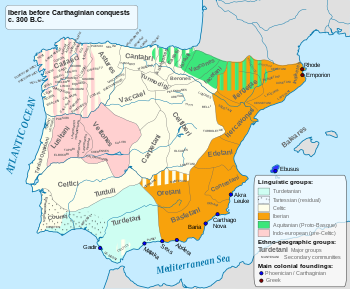TheOretaniorOretanii(Greek:Orissioi)[1]were a pre-Romanancient Iberian people (in the geographical sense) of theIberian Peninsula(the RomanHispania), that lived in northeasternAndalusia,in the upperBaetis(Guadalquivir) river valley, easternMarianus Mons(Sierra Morena), and the southern area of present-dayLa Mancha.

Origins
editThey could have been anIberiantribe, aCelticone, or a mixed Celtic and Iberian tribe or tribal confederacy (and hence related to theCeltiberians). TheMantesani/Mentesani/Mantasaniof present-dayLa Manchaand theGermani(of Oretania) in easternMarianus Mons(Sierra Morena) and westJabalónriver valley are sometimes included in the Oretani, but it is not certain if they were Oretani tribes.
Territory
editOretania, the country of the Oretani, was located in the easternSierra Morena,which included most of theprovince of Ciudad Realexcept its western end, the northern section ofthe province of Jaén,the western half of theprovince of Albacete.The Roman geographerPliny the Elderlists 14 cities, includingTuia/Tugia(perhapsToya),Salaria(perhapsÚbeda/Baeza),Biatia,Castulo/Castulum(presumed capital, later becoming a Visigothic bishopric; medieval name Cazlona, inJaén),[2]Luparia,CervariaandSalica,[3]whilstDiodorus Siculuslists 12 towns.[4]
Other sources mention the towns ofLibissosa(perhapsLezuza),[5]Amtorgis,Ilorci,Helicen/Helike(perhapsElche de la SierraorElche),[6]Baecula/Bekor(Bailén,Jaén),[7][8]Ilucia,NobilaandCusibi.[9]
Culture
editThey are believed by some to have spoken anIberian language,by others to have beenCeltic language,akin to theCeltiberians,as the northern Oretani were also calledGermaniandMantesani. The main archaeological sites in the Oretanian area areLinares,La Carolina,Montiel,Valdepeñas,Almagro,Oreto and Zuqueca,andCerro de las Cabezas.
History
editThe Oretani remained independent until the late 3rd Century BC, when their powerfulKing Orisonwas defeated at theBattle of Helicenin 228 BC.[10]Orison's defeat in 227 BC[11]and the subsequent alliance withCarthage,however, caused major friction with theirGermaniallies who continued to resist Punic expansion until being subdued byHannibalin 221 BC; the latter were certainly amongst the Oretani troops sent toAfricaat the outbreak of theSecond Punic War.
Romanization
editLike theGermani,the Oretani appear to have adopted a less hostile stance towardsRomeand in 156 BC both peoples were included intoHispania CiteriorProvince, though retaining their Iberian cultural identity for several more centuries.
See also
editNotes
edit- ^Rosario Garcia Huelva & Francisco Javier Morales Hervás,Los OretanosinPrehistoria y Protohistoria de la Meseta Sur (Castilla-La Mancha)(2007), p. 217.
- ^Strabo,Geographikon,III, 3, 2.
- ^Pliny the Elder,Naturalis Historia,III, 19.
- ^Diodorus Siculus,Bibliotheca historica,25, 42.
- ^Rosario Garcia Huelva & Francisco Javier Morales Hervás,Los OretanosinPrehistoria y Protohistoria de la Meseta Sur (Castilla-La Mancha)(2007), p. 218.
- ^Appian,Iberiké,6; 65.
- ^Polybius,Istorion,10, 38, 7; 11, 20.
- ^Livy,Ab Urbe Condita,27: 18; 28: 13.
- ^Livy,Ab Urbe Condita,35: 7, 6; 22: 5.
- ^Appian,Iberiké,6.
- ^Diodorus Siculus,Bibliotheca historica,25, 42.
References
edit- Ángel Montenegroet alii,Historia de España 2 - colonizaciones y formación de los pueblos prerromanos (1200-218 a.C),Editorial Gredos, Madrid (1989)ISBN84-249-1386-8
- Francisco Burillo Motoza,Los Celtíberos – Etnias y Estados,Crítica, Grijalbo Mondadori, S.A., Barcelona (1998, revised edition 2007)ISBN84-7423-891-9
- Juan Pereira Siesto (coord.),Prehistoria y Protohistoria de la Meseta Sur (Castilla-La Mancha),Biblioteca Añil n.º 31, ALMUD, Ediciones de Castilla-La Mancha, Ciudad Real (2007)ISBN84-934858-5-3